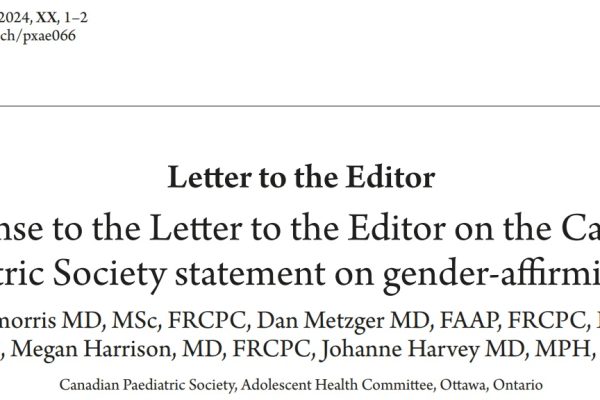The summer Olympics is less than 200 days away and many people are clearly becoming alarmed at the growing trend of trans-women competing as females in women’s sporting events. While many had voiced great hopes that the International Olympic Committee would update their transgender self-ID policy in time for Tokyo 2020 to ensure fairness for female athletes, the IOC remained strangely quiet on the issue right up to the end of 2019. Clearly, the IOC is prepared to let the gender self-ID experiment run its course irrespective of potential upheaval in the female category.
We wondered how these policies have taken effect across the many sporting organizations in Canada. Cycling Canada, for example, allows trans-athletes to compete in whichever gender category they self-identify. This policy has stripped medals and other benefits from a number of deserving female athletes.
Most Canadian sporting organizations have been pressured to cut and paste new guidance on Trans-inclusivity from a document produced in 2015 by the Canadian Center for Ethics in Sport.
The guidance document acknowledges that sex and gender are different:
We now know that sex and gender are not the same thing, and that individuals are born with different combinations of sex and gender as part of their identity.
CCES Trans Inclusion in Sport Expert Working Group
But the policy guidance comes down to the following directive:
It is a human right to be recognized as the gender with which you identify. The Expert Working Group held strongly to the principle that the inclusion of all athletes, based on the fundamental human right of gender self-determination overrides any consideration of potential competitive advantage.
CCES Trans Inclusion in Sport Expert Working Group
[A note on the Expert Working Group: The composition of the group overwhelmingly represents a “Trans” bias. The primary medical expert was Dr. Stephen Feder, the co-director of the gender diversity clinic at CHEO, the children’s hospital in Ottawa and a co-investigator on the TransYouthCan! research team studying trans youth being referred for puberty blockers. The Expert Working Group failed to include any other medical professional or human biologist with an alternative viewpoint.]
The policy position of the working group presumes (indeed, it demands!) that inclusion in sport is based on gender, not biological sex. There is significant discussion on “respecting everyone’s individual gender journey” rather than acknowledging the primacy of biology when it comes to performance capacity in sport. In their view, gender self-determination “overrides” all considerations.
The guidance acknowledges a distinction between recreational and high-performance sport, in terms of the emphasis on different sporting participation principles. It is obvious, however, that the Expert Working Group behind the guidance had a very clear mandate – to enforce gender self-id within all Canadian sports organizations.
The inclusion-first philosophy continues to apply when developing policy at the high-performance level. While the True Sport Principles of Play Fair and Go For It receive greater consideration at this level, it remains important to start from the assumption that it is a fundamental human right for everyone to be recognized in the gender with which they identify. Nor should there be any requirement for disclosure of trans status.
CCES Trans Inclusion in Sport Expert Working Group
While it’s not explicitly stated, “disclosure of trans status” likely refers to the requirement to disclose both biological sex and gender. The mismatch between sex and gender would reveal a trans athlete.
The best practices sections of the guide focus on “inclusivity” principles, for example that “key organizational documents proactively state the organization’s intention to be inclusive” including “prohibitive grounds for discrimination”. Any organization who adopts these policies is effectively buying into the idea that sport is categorized based on gender, and not biological sex. This position fails to consider that allowing a male body into a female competition could be a situation that is tantamount to “discrimination on the basis of sex” – which remains a possible basis for discrimination under the Canadian Human Rights Act and Charter of Rights and Freedoms.
The threatening language of “discrimination” regarding trans-athletes would make most organizations extremely reluctant to pursue sporting policies based on sex rather than on gender self-identification.
Nevertheless, some sports associations are being more careful and deliberate in their approach. In contrast to the Cycling Canada approach, Athletics Alberta (the association responsible for track and field, cross-country and road running in Alberta) considers “gender identity” (a psycho-social construct) to be incidental to sport categorization. In their view, participants compete according to their biological sex irrespective of such things as social status, religion, political affiliation, employment status, marital status, sexual orientation or any other factors that determine a participant’s self-identity. As has always been the case, athletes, coaches and officials indicate biological sex when they register for membership in Athletics Alberta.
The Athletics Alberta Code of Conduct reflects the principle of Fair Play. It is not acceptable, for example, to misrepresent oneself in terms of age or biological sex. They have updated their non-bullying policy to ensure that anyone who treats a trans-person in a negative manner would face disciplinary action.
The guiding principle in the updated Athletics Alberta Code of Conduct states:
Athletics Alberta is committed to being inclusive and respectful of all participants in the sport of Track & Field Athletics. For the purpose of eligibility, members of Athletics Alberta compete on the basis of biological sex classification. Since male sex confers physical performance advantages, it is particularly important to ensure that the female sex category is protected.
Athletics Alberta
This policy ensures fair play for everyone while maintaining the integrity of sport and fair competition based on sex, not gender. Hence, since male athletes have built-in physical advantages, they will always compete as males. Any male who self-identifies as a “woman” or “girl” will be treated with utmost dignity by the other males in the group.
The policy also takes into consideration FTM (female to male) transitioners who may be undergoing hormone therapy. Female athletes may compete in either sex category until such time as their testosterone level exceeds a particular threshold, and then they are required to compete in the male category. The biology-based eligibility guidelines are clear, as shown below.
- Male-born Transathlete must compete in the male category.
- Female-born Transathlete has the option of competing as male or female under the following provisions:
- Permitted to compete as male irrespective of intervention strategy undertaken to alter sex.
- Permitted to compete as female after careful review of the individual case. The female-born athlete who self-declares as transgender must submit documentation from a Medical Practitioner concerning the nature of gender reassignment intervention. Inclusion in the female category will be permitted if it is deemed that the intervention has not resulted in the participant having a competitive advantage over fellow female athletes. For example, testosterone supplementation commonly used in the medical treatment of gender reassignment might cause the athlete to be in violation of international anti-doping guidelines. In the case of developmental situations (athletes still growing and developing), a female athlete found to have testosterone concentration exceeding the upper limit of the normal female range for the given age category (as reported in biomedical research), will be ineligible to compete as female.
“Biological sex was always our policy”, said Dr. Linda Blade, President of Athletics Alberta. “This was the best inclusivity we could achieve without hurting anyone else. It’s a reinforcement of what we’ve always done, with a new emphasis on respect and fair play.”
Biological sex was always our policy. This was the best inclusivity we could achieve without hurting anyone else. It’s a reinforcement of what we’ve always done, with a new emphasis on respect and fair play.
Dr Linda Blade
Sporting organizations have a responsibility to ensure that fair play and respectful participation occur and to determine who can participate in their sport and under what conditions.
The CCES Trans-inclusivity guidance does little to increase acceptance of trans-athletes by ensuring they are treated with dignity and respect. Instead, it creates a policy environment of fear and intimidation for anyone who doesn’t adopt the dogma of gender self-id as the basis for inclusivity of trans-people in sport. This conflates biology and gender and does not provide a “new space” for trans-athletes where both biological sex and gender can co-exist as protected characteristics under law.
The Canadian Centre for Ethics in Sport has missed a great opportunity to leverage the unique capacity of sport to strengthen social ties and networks and to promote tolerance and acceptance. Instead, they created a policy that undermines sport for all female athletes and ignores the reason why sports categories were created in the first place – the fact that there are vast biological differences between the sexes.
Sport is clearly an area where biology and gender need to be regarded as two distinct concepts. Just as Athletics Alberta has taken a balanced approach to ensure the needs of all sporting participants are met, it is hoped that sports associations across Canada will follow suit by crafting their own policies in a manner that fosters dignity and respect for all participants.




The Athletics Alberta approach makes perfect sense. It does not bar anyone from competing, but only dictates what under what category they may compete in,
The guidelines proposed by CCES, on the other hand, are potentially unworkable, as they’ll find out if and when biological women begin getting shut-out from the podium en masse.
Thank you Athletics Alberta. If only everyone else could get it right.
Having spent 45 years in supporting and promoting women runners and coached an all-women running team I am appalled at the direction most of Canada has taken. The first year I ran the Boston Marathon women were not allowed to compete. I was fortunate enough to be a race director for the Avon Running Circuit, an international circuit of women-only races leading up to the annual Avon International Marathon which was run in a different city every year and was held in Ottawa in 1981. To see the struggle of women to achieve parity with men in sports and the achievement at something close to parity was awesome. And now we have the political left creating an uneven playing field for women by allowing and even mandating the inclusion of biological males in sports is disgusting.
It is the current policy in Ontario that a biological male can compete in a women’s only running event and win the race, win prize money, set a new course record, and set a new national record.
This would have made a great skit for Seinfeld and his Bizarro World excpet it is not funny!
Bravo to Athletics Alberta the only athletics governing body in Canada for doing the right thing.
CCES has lost their mind. From an organization that derived from making the sports playing level by rooting out drugs cheats they are destroying women’s sports.